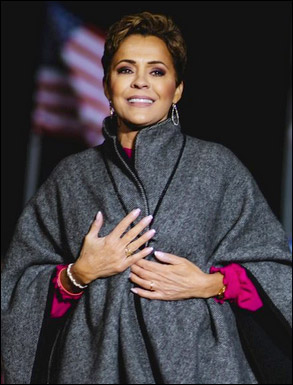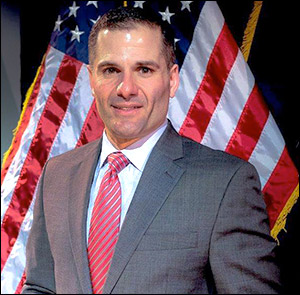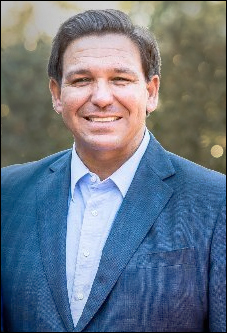(A Katie Hobbs ad that seems to test what could be her campaign’s change in direction.)
By Jim Ellis — Friday, Sept. 30, 2022
Governor
Arizona: Beneath the Surface — A strange turn of events coming from Arizona leads us to question some of the most recent polling and whether or not there could be a conservative backlash forming. This would explain why the Democratic gubernatorial nominee is clearly moving to the ideological right with her campaign strategy.Secretary of State Katie Hobbs won the open Democratic nomination for governor with over 73 percent of the vote in early August. Former television news anchor Kari Lake (R) is her opponent, and many believed Hobbs would sweep past the latter once Donald Trump’s strong support for Lake became the central campaign issue. For the Aug. 2 primary, Lake enjoyed strong support from the former president, which helped her score a close 47-44 percent Republican primary victory over University of Arizona Regent Karin Taylor Robson.
The general election, however, has become much more competitive than many expected. Lake is running neck-and-neck with Hobbs. Lake is basically taking a Glenn Youngkin-style approach to Trump in the general election — that is, graciously accepting his endorsement but continuing to campaign individually for the office sought without making Trump a campaign factor. In the most recent polling, seven released surveys since Sept. 6, both candidates lead in three of the research studies and are tied in another.
In the three polls favoring Democrat Hobbs, her lead is one point in each survey. Of the three where Republican Lake holds an edge, her margin is four points in two of the three. During this same time-frame — Sept. 6th to the present — nine polls have been conducted and Sen. Mark Kelly (D) holds the lead over Republican Blake Masters in all with an average spread of just under six percentage points in the accompanying statewide campaign.
Seeing these Senate campaign numbers would suggest that Hobbs would feel comfortable remaining close to her Democratic base, figuring that the Kelly campaign would take the lead in driving the party turnout. Not so, when looking at her most recent ad (above).
The new Hobbs ad basically adopts Republican themes, and not the current Democratic approach. She doesn’t mention abortion, unusual for a Democratic candidate these days since the party has clearly adopted a national single-issue strategy surrounding the issue. The party candidates across the board continue along this campaign path because the strategists believe that emphasizing the pro-choice position above all else is the way toward energizing the casual Democratic voter, i.e., those who only vote in presidential elections.
Instead, Hobbs is talking about implementing a tax cut for over 800,000 Arizona families and ending the sales tax on baby formula, school supplies, and medicines. Moving to the right while Sen. Kelly has a discernible advantage over Masters even while being attacked for his liberal voting record is a surprising development.
It appears the Hobbs campaign team may have uncovered patterns and trends in their research that leads them to conclude Republicans are in considerably better political shape than the current polls suggest. The primary turnout is one clue. Some 235,000 more Republicans than Democrats voted in the 2022 Arizona primaries, thus suggesting a possible precursor to a strong election night this November.
Such a closing surge would also be consistent with the Arizona vote in the 2020 election. Then, Sen. Kelly led by an average of just under seven points through the month of October, but only defeated then-Sen. Martha McSally (R) by just two percentage points.
In the presidential campaign, Joe Biden led then-President Trump by an average of 2.5 percentage points over the final 22 polls conducted in the state, but only managed to carry the state by 10,457 votes of almost 3.4 million votes cast — or just .3 of one percent.
The Hobbs move to the right is unorthodox, but if successful will prove a Democratic candidate can win when “cutting across the grain.”
Oregon: Republican Drazan Takes Lead — A just-released DHM Research survey (Sept. 23-24; 600 likely Oregon general election voters) finds former state House Minority Leader Christine Drazan (R) taking a one-point lead over former state House Speaker Tina Kotek (D), with strong Independent candidate Betsy Johnson, a former Democratic state legislator, dropping well back.
The gubernatorial ballot test gives Drazan a 32-31-18 percent edge over her two opponents. When the pollsters asked a second question just centered around the three top contenders, the ballot test actually strengthened Drazan slightly, to a 35-33-21 percent margin. The last time a Republican was elected Oregon’s governor came in 1982. In terms of the state’s status perception, just 25 percent said that the Beaver State is headed in the right direction while 62 percent replied that Oregon is on the wrong track.
Senate
Arizona: Sen. Kelly Expands Advantage — After several mid-September polls found Republican US Senate challenger Blake Masters pulling to within the polling margin of error against Sen. Mark Kelly (D), two new surveys see the two-year incumbent pulling back ahead by a more substantial margin.
Suffolk University’s (Sept. 21-25; 500 likely Arizona voters; live interview) latest study reports a seven-point spread in the senator’s favor, 49-42 percent. Marist College’s new likely voter survey (Sept. 19-22; 1,076 likely Arizona voters; live interview, text & online) found a slightly smaller Kelly lead, 50-45 percent. The Arizona race continues to be one to watch, especially considering the late GOP surge that occurred here in 2020.
Washington: Another Outlier — Yesterday, we reported on The Trafalgar Group’s new September poll that posted Sen. Patty Murray’s (D) to a 49-47 percent lead over Republican Tiffany Smiley and suggested the poll may be an outlier, since no other firm found such a close division between the two major candidates.
Now we see Democratic pollster Public Policy Polling quickly countering with a new survey of their own (Sept. 27-28; 770 Washington voters). The PPP response gives Sen. Murray a much stronger 52-40 percent advantage. In the Aug. 2 Washington jungle primary, Sen. Murray outpaced Smiley, 52-34 percent.






